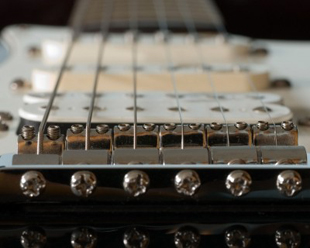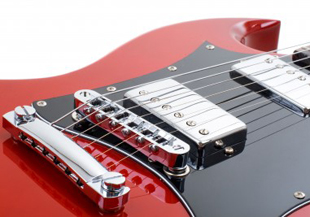Studio Skillset: Guitar & Bass Setups Part 2—Intonation
Last week, we learned how to quickly and easily diagnose and correct basic issues in the guitar’s neck, immediately improving playability and tone. Join us again this week as we zero in on the bridge to fix the intonation issues that drive listeners crazy.
INTONATION
An appropriately rickety-sounding guitar can fit perfectly in the right production, but in general, poor intonation will sap an instrument of the finer points of its tone, whether your sonic goal is power, sweetness, or clarity.
While the problems associated with poor action – dead spots or limited playability – are easy for anyone to spot, issues rooted in poor intonation are far more insidious. Plenty of players don’t realize there’s a problem with their guitar until they hear it under the microscope of a recording session.
A properly intonated guitar or bass sounds in-tune with itself, and with other instruments, no matter what register or chord is being played. Poor intonation is most often apparent in chords that won’t ring true no matter how carefully the strings are tuned, or in upper-register fretwork that always sounds a few shades off the mark.
For our purposes, we can think of intonation as how well each string stays in tune with itself throughout the entire scale-length of the guitar or bass.
HOW IT HAPPENS

Using a phillips head screw driver, adjust the working length of each strength for proper intonation.
Intonation can go out of whack when a guitarist changes strings and accidentally alters the placement of the bridge saddles. Or, it can suffer when the player switches to a new gauge of strings, which by nature, will require their own specialized adjustment.
Intonation can also use a tweak as the neck falls out of its original alignment, or as the nut slots deepen with wear and age. Finally, on more affordable guitars, there’s a pretty good chance that the instrument was never really set up very well at the factory to begin with.
Sometimes, the quickest and easiest fix for compromised intonation is a simple string change.
Old, crusty and worn-out strings have trouble staying in tune to begin with. Add the compromised intonation and weak tone that goes along with them, and you have the ingredients of a recording nightmare. A quick replacement with strings of the same gauge can do the trick, and improve tone on many levels.
If you’re staring at a fresh and broken-in set of strings and you’re still having intonation issues, it’s time to take the battle to the bridge.
BACK IN THE SADDLE
Our most effective weapon against intonation issues is the lateral (front to back) position — the bridge saddles. For those of you who don’t know, the saddles are the parts of the bridge that make contact with the strings.
Although saddles are rarely adjustable on acoustic guitars, and barely adjustable on bowed instruments and banjos, electric guitar and bass players often have the luxury of individually adjustable ones. These can usually be adjusted with a small Phillips-head screwdriver, although older Gibson bridges will require a flat-head. In some cases, having a set of electronic screwdrivers can also be helpful.
(Author’s Note: Most electrics will allow you to adjust the height of the saddles as well. This can be handy in case your adjustments to the neck weren’t enough to get the instrument’s action together and remove buzzes. If needed, feel free to play with the height of the saddles.
It’s nearly impossible to break anything by doing so, but remember that it is ill-advised to adjust the saddle heights if you haven’t adjusted the neck first. For this primer, we’re going to leave the somewhat self-explanatory issue of saddle height alone and focus on the lateral position of the saddles and how they effect intonation. This should always be done as the last step.)
DIAGNOSTICS
To check a guitar’s intonation, first plug it into an electronic tuner and tune normally.
Once that’s done, play a 12th-fret harmonic on your highest string, and look at the reading on the tuner. (This is done by lightly tapping the string just over the 12th fret with one hand, as you pluck the string with the other.) Then, fret the string normally at the 12th fret and play it again.
Chances are, the two readings are different, and this is the source of all your woes.
OPERATION
If the fretted note at the 12th fret was flat compared to the 12th-fret harmonic, turn the bridge saddle screws counter-clockwise, moving the saddle closer to the pickups, and shortening the working length of the string.
If the fretted note was sharp, turn the saddle screws clockwise, moving the saddle further from the pickups and lengthening the scale of the string.
For this adjustment, use half or three-quarter turns to start. After each tweak, be sure to re-tune the string. Adjusting the saddles changes the pitch of the string, so you’ll need to get it back to the desired note before measuring again. Repeat this process on each of the strings until done. Then, sit back and marvel at the improved tone of this newly-calibrated instrument.
CLOSING REMARKS
The first time you go through this basic version of the setup process, it could take an hour. If you’re lucky, with a little help from this guide, you might start getting somewhere quicker than that.
If you have an instrument to practice on, after a while, it’s not too difficult to start making these powerful adjustments in 10-15 minutes. Once you’ve had success a few times, you may even become comfortable enough to give a misbehaving instrument a once-over mid-session.
A few words of caution:
- If you’re dealing with someone’s prize instrument, be sure to ask permission, and remember to honestly describe your level of comfort and experience.
- Never be over-zealous with a truss rod. Go slowly and give up at the first sign of resistance.
- Be sure to take care when using pointy metal things like screwdrivers near a nice-looking guitar. Even the steadiest hand can slip and permanently scar a finish.
- It may sound obvious, but use due caution whenever you’re changing or tuning metal strings. Protective eyewear isn’t always available in the studio, but it’s good practice to turn your head and face away from strings when things are getting tight.
Lastly, don’t plan on replacing your repairman. Qualified guitar technicians are wizards, and an undervalued resource to new players and established studios alike. There’s more to a great setup than the essential fixes covered here. A guitar that’s been restored or maintained by a pro is a breeze to tweak in the field.
That said, get some time in with your tuner and Allen keys, and soon enough, you may just have the skills to salvage a tone and the good luck to save a session.
Justin Colletti is a Brooklyn-based producer/engineer who works with uncommon artists, and a journalist who writes about music and how we make it. Visit him at http://www.justincolletti.com.
Please note: When you buy products through links on this page, we may earn an affiliate commission.








Eblicker
October 6, 2011 at 7:06 pm (14 years ago)I have found the easy thing to remember when doing this is
Flat Forward
Sharp Back